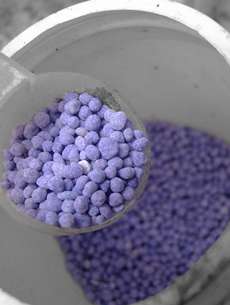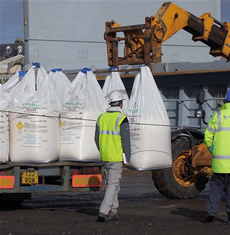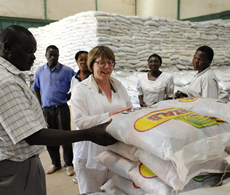Agriculture
Fertilizers are materials used to modify the chemical composition of soil in order to enhance plant growth. They represent an important use of natural resources because agricultural systems depend upon an ability to retain soil fertility.
Soil is a dynamic, chemically reactive medium, and agricultural soils must provide structural support for plants, contain a sufficient supply of plant nutrients, and exhibit an adequate capacity to hold and exchange minerals.
Topsoil, the 6-inch layer of soil covering the earth?s landmasses, is the root zone for the majority of the world?s food and fiber crops. As plants grow and develop, they remove the essential mineral nutrients from the soil. Because crop production normally requires the removal of plants or plant parts, nutrients are continuously being removed from the soil.
Therefore, the long-term agricultural use of any soil requires periodic fertilization to replace these lost nutrients. Fertilizers are associated with every aspect of this nutrient replacement process. The application of fertilizer is based on a knowledge of plant growth and development, soil chemistry, and plant-soil interactions.
Soil Nutrients
Plants require an adequate supply of both macronutrients (calcium, magnesium, sulfur, nitrogen, potassium, and phosphorus) and micronutrients (iron, copper, zinc, boron, manganese, chloride, and molybdenum) from the soil.
If any one of these nutrients is not present in sufficient amounts, plant growth and, ultimately, yields will be reduced. Because micronutrients are required in small quantities, and deficiencies in these minerals occur infrequently, the majority of agricultural fertilizers contain only macronutrients.
Although magnesium and calcium are utilized in large quantities, most agricultural soils contain an abundance of these two elements, either derived from parent material or added as lime.
Most soils also contain sufficient amounts of sulfur from the weathering of sulfur-containing minerals, the presence of sulfur in other fertilizers, and atmospheric pollutants.
The remaining three macronutrients (nitrogen, potassium, and phosphorus) are readily depleted and are referred to as fertilizer elements. Hence, these elements must be added to most soils on a regular basis.
Fertilizers containing two or more nutrients are called mixed fertilizers. A fertilizer labeled 10-10-10, for example, means that the product contains 10 percent nitrogen, 10 percent phosphorus, and 10 percent potassium.
These elements can be supplied in a number of different forms, some of which may not be immediately useful to plants. In the United States, where fertilizer labeling is regulated for sales, most states require that the label reflect the percentage of nutrients available for plant use.
Fertilizers are produced in a wide variety of single and mixed formulations, and the percentage of available nutrients generally ranges from a low of 5 percent to a high of 33 percent. Mixed fertilizers may also contain varying amounts of different micro nutrients.
Sources and Production
Nitrogen fertilizers can be classified as either chemical or natural organic. Natural organic sources are derived from plant and animal residues and include such materials as animal manure, cottonseed meal, and soybean meal.
Because natural organic fertilizers contain relatively small amounts of nitrogen, commercial operations rely on chemical fertilizers derived from sources other than plants and animals.
Major chemical sources of nitrogen include ammonium compounds and nitrates. The chemical fixation of atmospheric nitrogen by the Claude-Haber ammonification process is the cornerstone of the modern nitrogen fertilizer manufacturing process.
Once the ammonia is produced, it can be applied directly to the soil as anhydrous ammonia, or it can be mixed with water and supplied as a solution of aqueous ammonia and used in chemical reactions to produce other ammonium fertilizers, urea, or nitrates for nitrate fertilizers.
Some organic fertilizers contain small amounts of phosphorus, and organically derived phosphates from guano or acid-treated bone meal were used in the past. However, the supply of these materials is scarce.
Almost all commercially produced agricultural phosphates are applied as either phosphoric acid or super phosphate derived from rock phosphate. The major phosphate component in commercially important deposits of rock phosphate is apatite.
The apatite is mined, processed to separate the phosphorus-containing fraction from inert materials, and then treated with sulfuric acid to break the apatite bond. The super phosphate precipitates out of the solution and sets up as a hard block, which can be mechanically granulated to produce a fertilizer containing calcium, sulfur, and phosphorus.
Potassium fertilizers, commonly called ?potash,? are also obtained from mineral deposits below the earth?s surface. The major commercially available potassium fertilizers are potassium chloride extracted from sylvanite ore, potassium sulfate produced by various methods (including extraction from langbeinite or burkeite ores or chemical reactions with potassium chloride), and potassium nitrate, which can be manufactured by several different chemical processes. Although limited, there are sources of organic potassium fertilizers, such as tobacco stalks and dried kelp.
While the individual nitrogen, phosphorus, and potassium fertilizers can be applied directly to the soil, they are also commonly used to manufacture mixed fertilizers. Between two and ten different materials with widely different properties are mixed together in the manufacturing process.
The three most common processes used in mixed fertilizer production are the ammonification of phosphorus materials and the subsequent addition of other materials, bulk blending of solid ingredients, and liquid mixing.
Fillers and make-weight materials are often added to make up the difference between the weight of fertilizer materials required to furnish the stated amount of nutrient and the desired bulk of mixed products. Mixed fertilizers have the obvious advantage of supplying all the required nutrients in one application.
Application and Environment
The application of fertilizer to agricultural soil is by no means new. Farmers have been applying manures to improve plant growth for more than four thousand years. For the most part, this practice had little environmental impact. Since the development of chemical fertilizers in the late nineteenth century, however, fertilizer use has increased tremendously.
During the second half of the twentieth century, the amount of fertilizer applied to the soil increased more than 450 percent. While this increase has more than doubled the worldwide crop production, it has also generated some environmental problems.
The production of fertilizer requires the use of a variety of natural resources, and some people have argued that the increased production of fertilizers has required the use of energy and mineral reserves that could have been used elsewhere.
For every crop, there is a point at which the yield may continue to increase with the application of additional nutrients, but the increase will not offset the additional cost of the fertilizer.
The economically feasible practice, therefore, is to apply the appropriate amount of fertilizer that produces maximum profit rather than maximum yield. Unfortunately, many farmers still tend to over fertilize, which wastes money and contributes to environmental degradation.
Excessive fertilization can result in adverse soil reactions that damage plant roots or produce undesired growth patterns. Over fertilization can actually decrease yields. If supplied in excessive amounts, some micronutrients are toxic to plants and will dramatically reduce plant growth.
The most serious environmental problem associated with fertilizers, however, is their contribution to water pollution. Excess fertilizer elements, particularly nitrogen and phosphorus, are carried from farm fields and cattle feedlots by water runoff and are eventually deposited in rivers and lakes, where they contribute to the pollution of aquatic ecosystems.
High levels of plant nutrients in streams and lakes can result in increased growth of phytoplankton, a condition known as eutrophication. During the summer months, eutrophication can deplete oxygen levels in lower layers of ponds and lakes. Excess nutrients can also be leached through the soil and contaminate underground water supplies.
In areas where intense farming occurs, nitrate concentrations are often above recommended safe levels. Water that contains excessive amounts of plant nutrients poses health problems if consumed by humans and livestock, and it can be fatal if ingested by newborns.
Importance to Food Production
Without a doubt, the modern use of fertilizer has dramatically increased crop yields. If food and fiber production is to keep pace with the world?s growing population, increased reliance on fertilizers will be required in the future.
With increasing attention to the environment, future research will be aimed at finding fertilizer materials that will remain in the field to which they are applied and at improving application and cultivation techniques to contain materials within the designated application area.
The use of technology developed from discoveries in the field of molecular biology to develop more efficient plants holds considerable promise for the future.
- Nutrient Pollution
Nutrient pollution refers to a form of pollution in which nutrients, usually nitrogen and phosphorus, which are present in high concentrations is harmful to the ecosystem. Nutrient pollution is primarily a problem in aquatic ecosystems such as streams,...
- Nutrition In Agriculture
Nutrition in AgricultureExtensive research has been conducted to investigate the nutritional requirements of different crops and ways to enhance soil fertility, which has greatly benefited agricultural production. Even though people have known for more...
- Hydroponic Fertilizer Solutions
Plants typically grow with their roots in soil and their stems and leaves in the air. They get some of the elements they require from the air (for example, most of the carbon and much of the oxygen used by the plant comes from the carbon dioxide taken...
- Phosphorus In The Agricultural Environment -ii
Manufacturing Commercial Phosphate Fertilizer : Phosphate as an organic phosphorus source crops have been used for centuries. Even the appearance of P fertilizer technology process, from animal manure and sewage sludge composting, including the still...
- Phosphorus In The Agricultural Environment-i
Manufacturing Commercial Phosphate Fertilizer The commercial production of phosphate fertilizers with phosphoric acid production begins. A generalized construction of various different phosphate fertilizers used in step 1 picture images displayed are...
Agriculture
Fertilizers
 |
| Fertilizers |
Soil is a dynamic, chemically reactive medium, and agricultural soils must provide structural support for plants, contain a sufficient supply of plant nutrients, and exhibit an adequate capacity to hold and exchange minerals.
Topsoil, the 6-inch layer of soil covering the earth?s landmasses, is the root zone for the majority of the world?s food and fiber crops. As plants grow and develop, they remove the essential mineral nutrients from the soil. Because crop production normally requires the removal of plants or plant parts, nutrients are continuously being removed from the soil.
Therefore, the long-term agricultural use of any soil requires periodic fertilization to replace these lost nutrients. Fertilizers are associated with every aspect of this nutrient replacement process. The application of fertilizer is based on a knowledge of plant growth and development, soil chemistry, and plant-soil interactions.
Soil Nutrients
Plants require an adequate supply of both macronutrients (calcium, magnesium, sulfur, nitrogen, potassium, and phosphorus) and micronutrients (iron, copper, zinc, boron, manganese, chloride, and molybdenum) from the soil.
If any one of these nutrients is not present in sufficient amounts, plant growth and, ultimately, yields will be reduced. Because micronutrients are required in small quantities, and deficiencies in these minerals occur infrequently, the majority of agricultural fertilizers contain only macronutrients.
 |
| Soil Nutrients |
Most soils also contain sufficient amounts of sulfur from the weathering of sulfur-containing minerals, the presence of sulfur in other fertilizers, and atmospheric pollutants.
The remaining three macronutrients (nitrogen, potassium, and phosphorus) are readily depleted and are referred to as fertilizer elements. Hence, these elements must be added to most soils on a regular basis.
Fertilizers containing two or more nutrients are called mixed fertilizers. A fertilizer labeled 10-10-10, for example, means that the product contains 10 percent nitrogen, 10 percent phosphorus, and 10 percent potassium.
These elements can be supplied in a number of different forms, some of which may not be immediately useful to plants. In the United States, where fertilizer labeling is regulated for sales, most states require that the label reflect the percentage of nutrients available for plant use.
Fertilizers are produced in a wide variety of single and mixed formulations, and the percentage of available nutrients generally ranges from a low of 5 percent to a high of 33 percent. Mixed fertilizers may also contain varying amounts of different micro nutrients.
Sources and Production
 |
| Sources and Production |
Because natural organic fertilizers contain relatively small amounts of nitrogen, commercial operations rely on chemical fertilizers derived from sources other than plants and animals.
Major chemical sources of nitrogen include ammonium compounds and nitrates. The chemical fixation of atmospheric nitrogen by the Claude-Haber ammonification process is the cornerstone of the modern nitrogen fertilizer manufacturing process.
Once the ammonia is produced, it can be applied directly to the soil as anhydrous ammonia, or it can be mixed with water and supplied as a solution of aqueous ammonia and used in chemical reactions to produce other ammonium fertilizers, urea, or nitrates for nitrate fertilizers.
Some organic fertilizers contain small amounts of phosphorus, and organically derived phosphates from guano or acid-treated bone meal were used in the past. However, the supply of these materials is scarce.
Almost all commercially produced agricultural phosphates are applied as either phosphoric acid or super phosphate derived from rock phosphate. The major phosphate component in commercially important deposits of rock phosphate is apatite.
The apatite is mined, processed to separate the phosphorus-containing fraction from inert materials, and then treated with sulfuric acid to break the apatite bond. The super phosphate precipitates out of the solution and sets up as a hard block, which can be mechanically granulated to produce a fertilizer containing calcium, sulfur, and phosphorus.
Potassium fertilizers, commonly called ?potash,? are also obtained from mineral deposits below the earth?s surface. The major commercially available potassium fertilizers are potassium chloride extracted from sylvanite ore, potassium sulfate produced by various methods (including extraction from langbeinite or burkeite ores or chemical reactions with potassium chloride), and potassium nitrate, which can be manufactured by several different chemical processes. Although limited, there are sources of organic potassium fertilizers, such as tobacco stalks and dried kelp.
While the individual nitrogen, phosphorus, and potassium fertilizers can be applied directly to the soil, they are also commonly used to manufacture mixed fertilizers. Between two and ten different materials with widely different properties are mixed together in the manufacturing process.
The three most common processes used in mixed fertilizer production are the ammonification of phosphorus materials and the subsequent addition of other materials, bulk blending of solid ingredients, and liquid mixing.
Fillers and make-weight materials are often added to make up the difference between the weight of fertilizer materials required to furnish the stated amount of nutrient and the desired bulk of mixed products. Mixed fertilizers have the obvious advantage of supplying all the required nutrients in one application.
Application and Environment
 |
| Application and Environment |
During the second half of the twentieth century, the amount of fertilizer applied to the soil increased more than 450 percent. While this increase has more than doubled the worldwide crop production, it has also generated some environmental problems.
The production of fertilizer requires the use of a variety of natural resources, and some people have argued that the increased production of fertilizers has required the use of energy and mineral reserves that could have been used elsewhere.
For every crop, there is a point at which the yield may continue to increase with the application of additional nutrients, but the increase will not offset the additional cost of the fertilizer.
The economically feasible practice, therefore, is to apply the appropriate amount of fertilizer that produces maximum profit rather than maximum yield. Unfortunately, many farmers still tend to over fertilize, which wastes money and contributes to environmental degradation.
Excessive fertilization can result in adverse soil reactions that damage plant roots or produce undesired growth patterns. Over fertilization can actually decrease yields. If supplied in excessive amounts, some micronutrients are toxic to plants and will dramatically reduce plant growth.
The most serious environmental problem associated with fertilizers, however, is their contribution to water pollution. Excess fertilizer elements, particularly nitrogen and phosphorus, are carried from farm fields and cattle feedlots by water runoff and are eventually deposited in rivers and lakes, where they contribute to the pollution of aquatic ecosystems.
High levels of plant nutrients in streams and lakes can result in increased growth of phytoplankton, a condition known as eutrophication. During the summer months, eutrophication can deplete oxygen levels in lower layers of ponds and lakes. Excess nutrients can also be leached through the soil and contaminate underground water supplies.
In areas where intense farming occurs, nitrate concentrations are often above recommended safe levels. Water that contains excessive amounts of plant nutrients poses health problems if consumed by humans and livestock, and it can be fatal if ingested by newborns.
Importance to Food Production
 |
| survive a food crisis |
With increasing attention to the environment, future research will be aimed at finding fertilizer materials that will remain in the field to which they are applied and at improving application and cultivation techniques to contain materials within the designated application area.
The use of technology developed from discoveries in the field of molecular biology to develop more efficient plants holds considerable promise for the future.
- Nutrient Pollution
Nutrient pollution refers to a form of pollution in which nutrients, usually nitrogen and phosphorus, which are present in high concentrations is harmful to the ecosystem. Nutrient pollution is primarily a problem in aquatic ecosystems such as streams,...
- Nutrition In Agriculture
Nutrition in AgricultureExtensive research has been conducted to investigate the nutritional requirements of different crops and ways to enhance soil fertility, which has greatly benefited agricultural production. Even though people have known for more...
- Hydroponic Fertilizer Solutions
Plants typically grow with their roots in soil and their stems and leaves in the air. They get some of the elements they require from the air (for example, most of the carbon and much of the oxygen used by the plant comes from the carbon dioxide taken...
- Phosphorus In The Agricultural Environment -ii
Manufacturing Commercial Phosphate Fertilizer : Phosphate as an organic phosphorus source crops have been used for centuries. Even the appearance of P fertilizer technology process, from animal manure and sewage sludge composting, including the still...
- Phosphorus In The Agricultural Environment-i
Manufacturing Commercial Phosphate Fertilizer The commercial production of phosphate fertilizers with phosphoric acid production begins. A generalized construction of various different phosphate fertilizers used in step 1 picture images displayed are...
